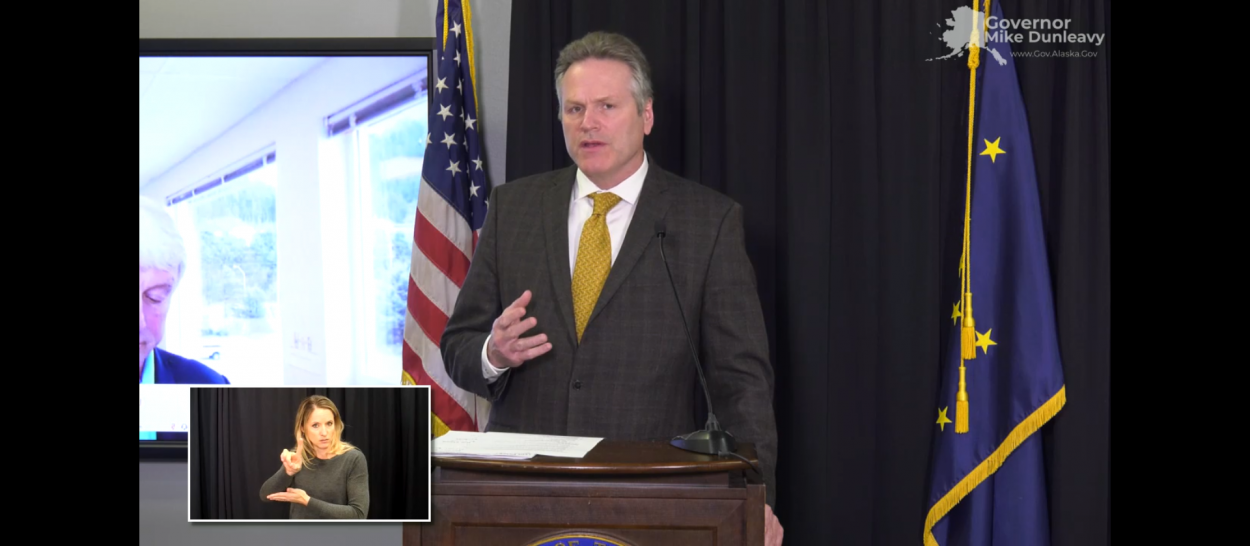
Gov. Mike Dunleavy announced $1.3 billion worth of vetoes during an April 7, 2020 press conference. (Screenshot by Jacob Resneck/CoastAlaska)
Federal coronavirus relief funds for schools likely won’t make up for the $30 million in education funding vetoed by Gov. Mike Dunleavy. That means school districts across the state are trying to figure out how to plug the gaps.
State lawmakers added $30 million extra for schools across Alaska in their most recent budget. But Dunleavy erased those funds in a line-item veto. When he announced his decision, he assured Alaskans that those cuts in “unrestricted general funds,” or UGF, would be made up by federal dollars.
“So, when it comes to reductions — for example, there was a $30 million veto on UGF that we did – I did – regarding education, there’s money in the CARES Act for education, for that replacement,” he said in an April 7 news conference.
In Ketchikan’s case. that meant nearly $600,000 gone from its budget. But district Business Manager Katie Parrott presented the school board with a budget built around the governor’s promise that once the federal money hit, it’d be a wash.
“The problem, however, is that it truly is not the same amount — it’s not matching that amount — for a few reasons,” Parrott said in a Monday phone interview.
These reasons include the fact that federal money has strings attached: there are things it can and cannot be spent on — “obviously, anything that’s directly related to the district’s response to the COVID situation” is eligible, Parrott said
That includes health-related expenses like deep-cleaning school buildings and buying more cleaning supplies. Tech upgrades for distance learning are also eligible for aid, which takes the form of state reimbursements.
“But the big difference is we can’t use it for core classroom requirements. We can only use it to respond to COVID-19,” said Jim Anderson, chief financial officer for the Anchorage School District.
He said his district had other plans for Anchorage’s approximately $8 million share of the state funding.
“Increase our classrooms, potentially mental health supports and other things,” he said in a phone interview Monday. “CARES Act money comes with strings, like all grant money from the federal government.”
And the relief money has to be shared with private schools, as well. And strict record-keeping requirements only make matters worse, said Ketchikan’s Katie Parrott — not to mention that districts are paying for pandemic-related expenses with the same amount of money the legislature earmarked for regular school budgets.
“The COVID situation has actually increased our costs, it hasn’t reduced our costs,” she said.
She says that means there will have to be cuts for things CARES Act funding can’t cover: notably, teacher and staff salaries. But Parrott says the district will likely be able to avoid layoffs: they’ll cut a couple new positions that haven’t been filled, reassign staff, and do some other budget wrangling.
But Norm Wooten, head of the Association of Alaska School Boards, said there’s a big question that hasn’t been answered yet.
“It’s not completely clear whether supplanting appropriated state funding is allowed under the CARES Act,” he said by phone Friday.
In fact, there’s a section of the CARES Act that specifically prohibits states from using federal funds to replace operating costs. In other words, states can’t cut their school budget and expect the feds to fill the gaps — which is what Alaska’s governor seems to have tried to do.
Within three weeks of Gov. Dunleavy’s vetoes, he fired off a letter to the Trump administration asking for leniency — another section of the relief package allows exemptions for states that have “experienced a precipitous decline in financial resources”.
In his letter to Education Secretary Betsy DeVos, he cites falling oil prices and the crumbling tourism season — and the resulting hit to state revenue — as justification for cuts in state education funding.
Back in Ketchikan, Katie Parrott listed these same factors for what worries her about future education funding.
“I’m trying to be optimistic, but it’s a concerning time,” she said.
It’s unclear whether the feds will grant Alaska its waiver. Governor’s office spokesperson Jeff Turner said Monday the state is still waiting for an answer.
In an email, Turner said that when Dunleavy explained his veto strategy to use federal money to backfill state cuts to schools last month, he was “operating under information that it was an allowable use of CARES Act funds…”
But he acknowledges that federal guidance since then has clarified that that isn’t allowed.
Alaska Public Media’s Nat Herz contributed reporting from Anchorage.








